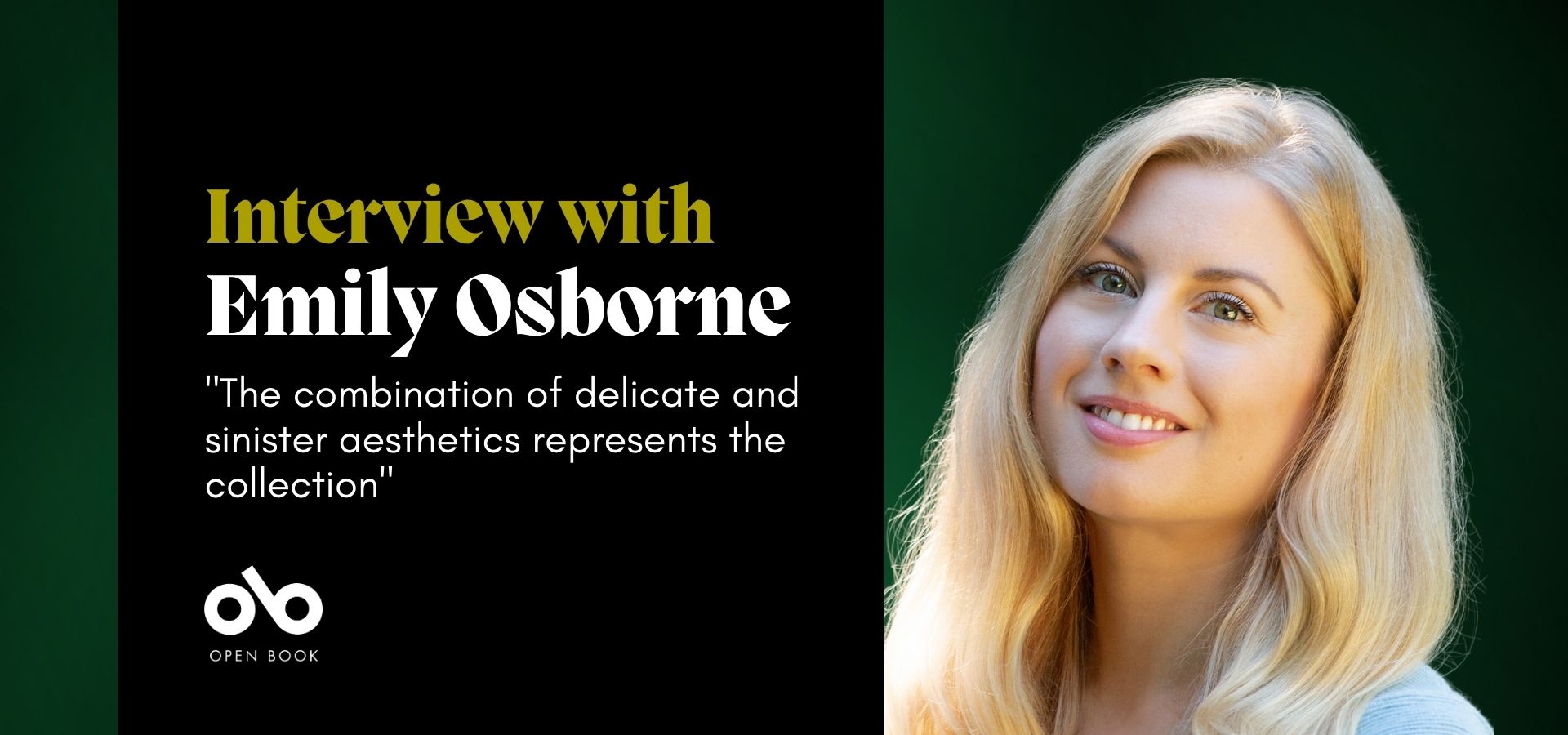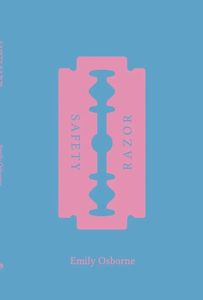Emily Osborne on Weaving Together Translations of Old Norse Skaldic Poetry with Personal Lyrics in Her Bold Debut
Sometimes in discussing poetry, there is an idea that a collection must swing towards either the personal and emotive, creating powerful connections with readers in that vein, or towards a more form-focused technical wizardry. But some collections prove you don't have to choose – that deeply vulnerable and raw lyrics can also weave in the historical, the academic, and the even the scientific.
Emily Osborne's debut, Safety Razor (Gordon Hill Press), does just that, combining translations from Old Norse with the more personal runes of motherhood, fierce love, and aging. Vikings, babies, a famous circus elephant, and tornados populate her pages, in poems both tough and tender, gritty and wise, encompassing both the precision and danger of Osborne's titular object.
We're speaking with Emily today about the collection, a conversation that is part of our Line & Lyric interview series for poets. She tells us about her unexpected route to choosing the book's title, the research involved in putting the collection and her translations together, and a sweet, book-related cure for insomnia that she and her husband devised together.
Open Book:
Can you tell us a bit about how you chose your title? If it’s a title of one of the poems, how does that piece fit into the collection? If it’s not a poem title, how does it encapsulate the collection as a whole?
Emily Osborne:
Originally the manuscript had a clunkier title that my editor, Shane Neilson, suggested I change. While re-reading the poems with an eye to finding a title, I thought about their repeated tension between safety and danger, and the recurring images of razors, sharpness, and injury. Suddenly, the term “Safety Razor” came into my mind and I knew it was the perfect title. My husband shaves with an elegant safety razor, and I often notice it in our bathroom as an object of beauty but also danger which we need to ensure is out of our young children’s reach. During the cover design process with Luke Hill, I initially requested not to have a razor image. However, when I saw how Luke had captured the blade’s elegant architecture, I was sold. The cover and title are jarring, and the combination of delicate and sinister aesthetics represents the collection.
OB:
Was there any research involved in your writing process for these poems?
EO:
All of my poems are grounded in research of some form. The translations from Old Norse of course involved hours of linguistic, textual, and contextual research. Then there is the question of how to communicate all of this information into verse that is accessible yet mosaic for an English-speaking audience who likely lacks the historical context I’m familiar with from my PhD. Answering this question requires study of the work of different translators, weighing what works and does not work, what is enjoyable or laborious.
Many poems in the collection are about historical subjects, such as Jumbo the Elephant, a geological time period, a concept from physics or DNA synthesis, or a form of engraving. Researching Jumbo the Elephant’s history was particularly interesting, because I encountered many articles (both nineteenth-century and contemporary) which portrayed him as a kind of media personality. My biographical poem grapples with this research process: the voice in the poem is finally unable to paint Jumbo as anything but a human construct subject to our whimsies and fads, and when it attempts to access his psychology, can only represent this in human terms. Another poem titled “Dinosaur bones” was quite fun to research; it looks at different ways dinosaur bones have been imagined in art, from early Victorian era paintings to modern cartoons.
Even if a poem is mostly about a memory or incident in my own life, I often research vocabulary around subjects or objects within the poem, and keep a page of words and concepts that I can look at and play around with. Poems become much richer when I do this and I struggle with writer’s block less often.
OB:
What were you reading while writing this collection?
Your CanLit News
Subscribe to Open Book’s newsletter to get local book events, literary content, writing tips, and more in your inbox
EO:
Lots of poetry by other Canadians. After living abroad for years, I wanted to refamiliarize myself with current Canadian poets. I read as much as I could, but authors whose books stick in my mind are Annick MacAskill, Juliane Okot Biket, Evelyn Lau, Rob Taylor, Carolyn Smart, Shane Neilson, Ken Babstock, David Ly, Aidan Chafe, and George Elliott Clarke. I also spent considerable time reading Tomas Tranströmer, comparing translations with the original Swedish.
Some standout novels were A.S. Byatt’s Fredericka Quartet; Marilynne Robinson’s Gilead series, War and Peace (finally read it!), Haruki Murakami’s Norwegian Wood, Mary Webb’s Precious Bane, and Zadie Smith’s On Beauty.
And at night, especially during bouts of insomnia, my husband would read children’s novels to me. We revisited lots of classics like Anne of Green Gables and The Secret Garden, as well as calming series like the Green Knowe novels by Lucy Boston and Swallows and Amazons by Arthur Ransome. A number of children’s fantasies by Diana Wynne Jones and Susan Cooper. I see the influence of these daily doses of children’s books in how I explore childhood memories in my book.
OB:
Is there’s an individual, specific speaker in any of these poems (whether yourself or a character)? Tell us a little about the perspective from which the poems are spoken.
EO:
The Norse skaldic poems employ first-person voice, and also, as is characteristic of the genre, draw attention to the individual act of speaking in composition. Although the voice in the poems is direct, their transmission history problematizes it. Most skaldic poems were passed down orally for centuries before being set within the prose of Icelandic sagas, and therefore their “original” composers or speakers are obscured. Given this history, I enjoy having this cryptic yet confrontational “I” voice speaking to the reader within my 21st-century collection. I’m not aware of any other book that sets the Norse skaldic poems within such a context.
Many of my lyrics are autobiographical or biographical (about people close to me) and these tend to employ expected first- or third-person voice. However, the autobiographical “I-poems” speak from different times, stretching back to toddler years. And some of the I-poems in the end of the collection actually embody family members’ experience as a projection of my own imagined old age. Several poems contain no speaker; instead objects are observed and commented on. In these poems, I enjoy playing around with the absences of voice. In the sonnet titled “Bullets,” dangers are listed in the isolated house of an elderly person, with a twist at the end where a voice mail “trills” and leaves “angst in garbled catalogues.”
One of my writing goals is to play more with voice and agency, perhaps even channel the kinds of medieval poems that allow inanimate objects to speak. Recently I wrote a sonnet inspired by the Exeter Book riddles, but in the end I inserted an autobiographical voice, so the goal wasn’t quite met.
OB:
What are you working on next?
EO:
Primarily I’m trying to finish a book of translations of Old Norse skaldic poetry. This will be the first multi-poet collection of English translations of skaldic verse aimed at a general audience. Skaldic poetry is notoriously difficult to translate, due to its system of complex embedded metaphors called kennings and its strict alliterative and syllabic schemes. Wonderful academic translations exist, but they aren’t very readable for non-scholars. My book aims to be fierce, fun, and comprehensive, containing poets of a variety of characters who composed on diverse subjects such as war, magic, love, sailing, diplomacy, and religion. The combination of poets gives a picture of life in Viking and medieval Scandinavian that is difficult to find elsewhere.
Progress on any writing project is slow right now because I have two young sons, but I’m also poking at a short story collection, with stories that involve the manipulation of space and time, as well as a fantasy novel.
__________________________________________
Emily Osborne’s poetry, short fiction, and Old Norse-to-English verse translations have appeared in journals and anthologies such as Vallum, CV2, The Polyglot, The Literary Review of Canada, Barren Magazine, and Althingi: The Crescent and the Northern Star. She is the author of the poetry chapbook Biometrical (Anstruther Press). In 2018, Emily won The Malahat Review’s Far Horizons Award for Poetry. After spending the first 22 years of her life in London, ON, Emily moved to the UK to complete an MPhil and PhD at Cambridge University, in Old English and Old Norse-Icelandic Literature. Currently, Emily lives on Bowen Island, BC, with her husband and two young sons. Safety Razor is her debut book of poetry.





